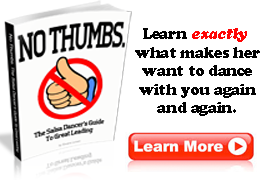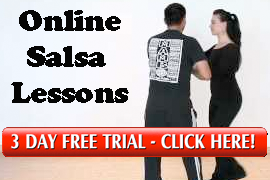Enjoy! The tips in this article can be used for social dancing as well as performing.
Written by DanceAdvantage.net
Some students seem like natural performers. They know how to “work a crowd,” they dance with energy, and seem to move with joy. Certainly, experience as a performer plays a big part in this. Like anything else, practice in performance allows you to learn what works and what doesn’t.
“Natural” performers, however, seem to know something that others do not. Here’s a list of some of these secrets. Actually, I’m not sure there is truly anything “secret” about these (I really couldn’t resist the alliteration), but perhaps these are tips and aspects of your dancing you haven’t put much thought into before. As you work toward your final performance be sure to put these skills into practice with as much (or more) diligence as learning your steps.
Super performers…
- Never dance alone, even in a solo. Include the audience in your performance. Do not forget or ignore that they’re there. If this makes you nervous, it may be useful to know that according to The Anxiety Treatment Center (Chicago area), involving the audience can actually lessen your anxiety or stage fright.
- Are aware of other dancers in the group. How can you involve the audience or the other dancers on stage with you in your performance? Make eye contact, direct your energy to one person within the audience or project your energy to the others around you, and use or respond to the energy of others give to you. None of these are things that you DO so much as things you FEEL and THINK as you perform.
- Super performers know… the eyes have it. Facial expression is important in dance but it’s more than just smiling in a performance. Real or sincere facial expression often has more to do with the eyes than with the mouth. So, rather than focusing on a “smiling” mouth, I suggest that students practice an “open” expression with their whole face but especially the eyes.
Although THINKING or FEELING this concept is at least half the battle, there are some things you can DO in this case. As you perform, engage the muscles in the face by slightly lifting the eyebrows – not to a comical extreme, but in a way that is comfortable and easy to maintain. It is the same expression most people use when making eye contact with or really listening to a friend, or when they are speaking excitedly in conversation. Audiences respond well to performers who utilize this technique. Truly SEE, LOOK, and TAKE IN the world through your eyes as you dance.
As for the rest of the face, be natural. While a smile can be important during certain types of dances, it will not match the mood in all dances. Relax the lower jaw. This will improve any type of expression and, if fitting, make possible a smile that comes easily but is not plastered to your face. - Super performers understand musicality. Everyone has a different way of thinking about the concept of musicality. While counting helps dancers to be precise and together in their movement, musicality in performance is expressed through more than just counting beats. When counting, it is easy to forget that a beat includes not only the sharp “tap” of a particular rhythm but also the space between those taps, just as all movements include transitions and shifts of weight between desired “shapes” of the body.
Exciting and musical performers fill these spaces in the music and movement, not letting the energy or intent drop between shapes or between counts. Enjoyable performers also utilize dynamics in their performance. Resisting “sameness,” as they dance, they incorporate crescendo and decrescendo (sudden or gradual changes in the quality of the movement) that often reflect or work within the accompanying music or score.
It is always helpful to have at least a basic understanding of music composition or theory but THINKING about what you FEEL and HEAR in music and applying these to your dance practice is the first step in bringing musicality to your performance. In fact, a performer can be musical even without dancing to music! - Super performers ooze confidence. Don’t confuse attitude with confidence. Attitude is something which is acted or portrayed. Just as any role would, attitude requires a level of confidence to be played well but, it is simply a layer or a persona the performer wears in his/her performance. Confidence is trust in yourself and in the situation but, it is not centered on the self.
Trust in yourself and your fellow dancers is the practical side of confidence and comes from preparation and experience. The work you put into the dance steps and sequence, the time and effort you put into class and technique, the build up of experience on stage or of situations in which you must improvise or think on your feet. These things allow a performer to trust.
Exuding confidence does not require one to act in a self-centered manner. In fact often it is quite the opposite. Dancers with confidence give a lot of themselves without dwelling on what the audience is thinking of them. This allows the performer to focus on making good use of all that preparation, overcome mistakes when they arise, and concentrate fully to the performance itself.
- Super performers are actors as well as dancers.I talked about acting when I mentioned attitude above. Just as musicians understand the music, actors understand the context (the situation, the scene, the conditions, and background) within which they are performing. Dancers, as actors, should be familiar with the time period or origin of the dance, understand the emotions of a piece or have an idea of what the choreographer is trying to express or intend.
Like actors, engaging performers, also “suspend disbelief” or, make the audience believe something even if it is not true or actual. Dancers pretend to be happy, curious, confused, or angry even when they are not. Much of being a convincing performer is making something seem real even to yourself – evoking emotions that were not present a second ago.
Being real in acting also involves observing and discovering what is natural or of human nature. If a prop accidentally falls to the floor during a performance, an actor who is being “natural” would not ignore it. What do you really do when something falls – do you try to catch it? I’m not saying that in a dance you should stop and pick up a prop when it falls (because timing can be crucial in a dance) but becoming an excellent performer requires investigation of and experimentation with different kinds of behavior (guided or otherwise). - Super performers are secretive. Hey, maybe there are some secrets in here! Although good acting usually reveals something to an audience, a good performer knows that playing one’s hand all at once is not a good idea. As a dance performer, you don’t always have control over the content or plot or story of your performance. The choreographer ultimately is responsible for this. But, it helps as you perform to imagine you are keeping a secret from the audience.
Think about how it feels to withhold something you want to share with someone else and apply that type of contained excitement or knowledge to your dancing. There may be natural points in the choreography that you might build toward or reveal portions of this secret — like opening birthday presents one at a time.
This may seem a little abstract but give it a try. Even if you don’t know what your secret is, pretending that you have one as you dance changes the energy on stage and has made for some compelling performances. It helps depict the fun in your dance without relying solely on happy or joyful feelings. After all, not every dance is happy but they can all have their secrets. - Super performers dance beyond their kinesphere. Kinesphere is a word used in dance that describes the space surrounding the body. It is the imaginary bubble that encircles your frame in stillness and as you move. Again, dancing beyond this bubble is something that you must IMAGINE as you dance, not necessarily something that you DO.
Moving with a sense of directing or expanding your energy beyond your kinesphere will not only make you a more engaging performer. If practiced throughout your classes as well, projecting energy beyond your fingertips and toes, out through the top of the head, from your eyes, or even from every cell in your body, can improve your execution of the movement as well.
When you dance, your purpose is not to get to a certain place on the floor. It’s to enjoy each step along the way. ~ Wayne Dyer
The more you understand the music, the easier you can dance. ~ Orlando Gutinez
The audiences ears hear the music, and their eyes see you being that music. Dance is the music made visible. You ARE the music! ~ Morocco
Don’t be afraid to be amazing. ~ Andy Offutt Irwin
Long experience has taught me that the crux of my fortunes is whether I can radiate good will toward my audience. There is only one way to do it and that is to feel it. You can fool the eyes and minds of the audience, but you cannot fool their hearts. ~ Howard Thurston
Remember that dance has a dimension beyond the physical. The body-as imperfect as it always is-is only part of the picture. Your energy, the quality of your movement, your feeling about the world, your dance spirit-that is what we see under the lights.~ Dance Magazine 3/05
When it comes to the requirements for pleasing an audience, all the knowledge and instruction and apparatus in the world is worth less than one ounce of soul. ~ Ottawa Keyes
Article by DanceAdvantage.net






Leave a Reply